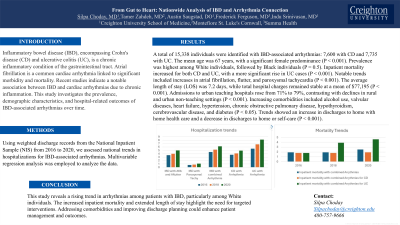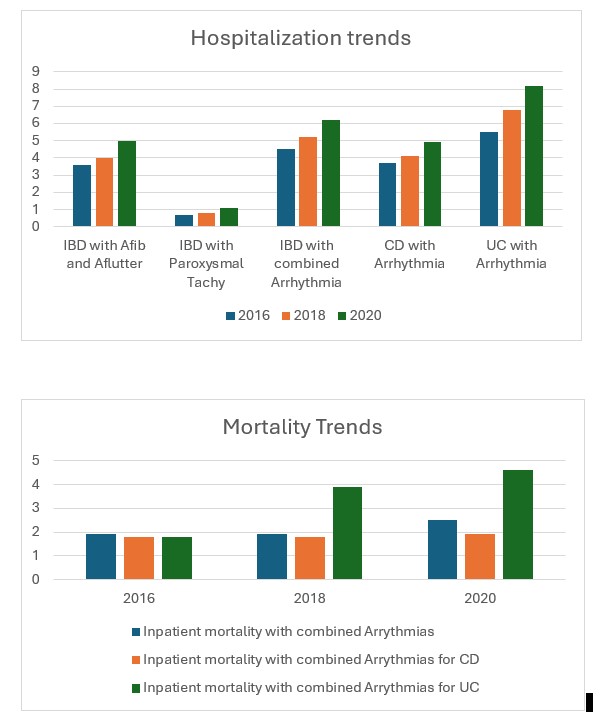Monday Poster Session
Category: IBD
P2657 - From Gut to Heart: Nationwide Analysis of IBD and Arrhythmia Connection
Monday, October 28, 2024
10:30 AM - 4:00 PM ET
Location: Exhibit Hall E

Has Audio

Silpa Choday, MD
Creighton University School of Medicine
Phoenix, AZ
Presenting Author(s)
Silpa Choday, MD1, Tamer Zahdeh, MD2, Austin Saugstad, DO1, Frederick Ferguson, MD3, Indu Srinivasan, MD4
1Creighton University School of Medicine, Phoenix, AZ; 2Montefiore St. Luke's Cornwall, New York, NY; 3Summa Health, Akron, OH; 4Creighton University Medical Center, Phoenix, AZ
Introduction: : Inflammatory bowel disease (IBD) is a chronic inflammatory condition of the gastrointestinal tract consisting of crohn's disease (CD) and ulcerative colitis (UC). Atrial fibrillation is one of the common cardiac arrhythmias associated with significant mortality and morbidity. Recent studies have highlighted a significant association between IBD and cardiac arrhythmias owing to state of chronic inflammation. This study aims to investigate the prevalence, demographic characteristics, and hospital-related outcomes of IBD-associated arrhythmias over time.
Methods: Using weighted discharge records from the National Inpatient Sample (NIS) from 2016–2020, we assessed the national trends in hospitalizations for IBD associated arrhythmia and investigate outcomes. Multivariable regression analysis is used to analyze the data.
Results: A total of 15,338 individuals were found to have IBD-associated arrhythmias, with 7,600 cases of CD and 7,735 cases of ulcerative colitis UC. The mean age was 67 years, with a female predominance (P < 0.001). The condition was most prevalent among White individuals, followed by Black individuals (P = 0.5). Inpatient mortality increased for both CD and UC, with a more significant increase in UC (P < 0.001). There was a rising trend in atrial fibrillation, flutter, and paroxysmal tachycardia over the years (P < 0.001). The average length of stay (LOS) was 7.2 days, while total hospital charges showed minimal change, with a mean of $77,195 (P < 0.001). Admissions to urban teaching institutions significantly increased from 71% to 79%, contrasting with a decline in rural and urban non-teaching settings (P < 0.001). Comorbidities with increasing trends included alcohol use, valvular diseases, heart failure, hypertension, chronic obstructive pulmonary disease, hypothyroidism, cerebrovascular disease, and diabetes (P < 0.05). There was an increasing trend in discharges to home with home health care and a decreasing trend in discharges to home or self-care (P < 0.001).
Discussion: The study highlights rising trend in arrhythmias among patients with IBD, with most prevalence among White individuals. Understanding the implications of this association is crucial for improving patient outcomes. The increased inpatient mortality and extended length of stay reinforce the need for targeted interventions including addressing the comorbidities and improving discharge planning which could potentially enhance the management and prognosis of these patients.

Note: The table for this abstract can be viewed in the ePoster Gallery section of the ACG 2024 ePoster Site or in The American Journal of Gastroenterology's abstract supplement issue, both of which will be available starting October 27, 2024.
Disclosures:
Silpa Choday, MD1, Tamer Zahdeh, MD2, Austin Saugstad, DO1, Frederick Ferguson, MD3, Indu Srinivasan, MD4. P2657 - From Gut to Heart: Nationwide Analysis of IBD and Arrhythmia Connection, ACG 2024 Annual Scientific Meeting Abstracts. Philadelphia, PA: American College of Gastroenterology.
1Creighton University School of Medicine, Phoenix, AZ; 2Montefiore St. Luke's Cornwall, New York, NY; 3Summa Health, Akron, OH; 4Creighton University Medical Center, Phoenix, AZ
Introduction: : Inflammatory bowel disease (IBD) is a chronic inflammatory condition of the gastrointestinal tract consisting of crohn's disease (CD) and ulcerative colitis (UC). Atrial fibrillation is one of the common cardiac arrhythmias associated with significant mortality and morbidity. Recent studies have highlighted a significant association between IBD and cardiac arrhythmias owing to state of chronic inflammation. This study aims to investigate the prevalence, demographic characteristics, and hospital-related outcomes of IBD-associated arrhythmias over time.
Methods: Using weighted discharge records from the National Inpatient Sample (NIS) from 2016–2020, we assessed the national trends in hospitalizations for IBD associated arrhythmia and investigate outcomes. Multivariable regression analysis is used to analyze the data.
Results: A total of 15,338 individuals were found to have IBD-associated arrhythmias, with 7,600 cases of CD and 7,735 cases of ulcerative colitis UC. The mean age was 67 years, with a female predominance (P < 0.001). The condition was most prevalent among White individuals, followed by Black individuals (P = 0.5). Inpatient mortality increased for both CD and UC, with a more significant increase in UC (P < 0.001). There was a rising trend in atrial fibrillation, flutter, and paroxysmal tachycardia over the years (P < 0.001). The average length of stay (LOS) was 7.2 days, while total hospital charges showed minimal change, with a mean of $77,195 (P < 0.001). Admissions to urban teaching institutions significantly increased from 71% to 79%, contrasting with a decline in rural and urban non-teaching settings (P < 0.001). Comorbidities with increasing trends included alcohol use, valvular diseases, heart failure, hypertension, chronic obstructive pulmonary disease, hypothyroidism, cerebrovascular disease, and diabetes (P < 0.05). There was an increasing trend in discharges to home with home health care and a decreasing trend in discharges to home or self-care (P < 0.001).
Discussion: The study highlights rising trend in arrhythmias among patients with IBD, with most prevalence among White individuals. Understanding the implications of this association is crucial for improving patient outcomes. The increased inpatient mortality and extended length of stay reinforce the need for targeted interventions including addressing the comorbidities and improving discharge planning which could potentially enhance the management and prognosis of these patients.

Figure: Hospitalization and Mortality Trends
Note: The table for this abstract can be viewed in the ePoster Gallery section of the ACG 2024 ePoster Site or in The American Journal of Gastroenterology's abstract supplement issue, both of which will be available starting October 27, 2024.
Disclosures:
Silpa Choday indicated no relevant financial relationships.
Tamer Zahdeh indicated no relevant financial relationships.
Austin Saugstad indicated no relevant financial relationships.
Frederick Ferguson indicated no relevant financial relationships.
Indu Srinivasan indicated no relevant financial relationships.
Silpa Choday, MD1, Tamer Zahdeh, MD2, Austin Saugstad, DO1, Frederick Ferguson, MD3, Indu Srinivasan, MD4. P2657 - From Gut to Heart: Nationwide Analysis of IBD and Arrhythmia Connection, ACG 2024 Annual Scientific Meeting Abstracts. Philadelphia, PA: American College of Gastroenterology.
